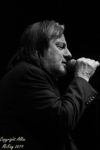 The Southside Johnny gig Commandments; they’re important, and you should always abide by them.
The Southside Johnny gig Commandments; they’re important, and you should always abide by them.
1st Commandment – Watch the support band. In my experience of, ahem, one or two Southside gigs, the support is always worth watching and Curse of Lono had been on my radar for a few years. Most of the audience followed the 1st Commandment and made the early start to catch Curse of Lono doing their second Southside support tour.
2nd Commandment – To reinforce the 1st Commandment, the support band(s) always get the same level of sound and lighting support as the Jukes.

3rd Commandment – Get to the venue early. You have been paying attention, haven’t you? The support band(s) are going to look and sound great. Trust me. Curse of Lono played at a ridiculously early time but a bunch of powerful songs (“Valentine” was a standout) delivered by a locked-in rhythm section (Neil Findlay and Charis Anderson) while Felix Bechtolsheimer’s vocals were underlined by Joe Hazell’s creative guitar lines and the keys of Dani Ruiz Hernandez. It’s a big sound it’s hugely appreciated by the gathering crowd. That’s another band on my ‘to watch’ list. Which leads me to…
4th Commandment – Show your appreciation for the support band(s). Jukes followers are fiercely loyal, but they’re music fans and if a band is good and gives it a bit of wellie, they’ll get right behind them. Which meant a great reception for Curse of Lono.
5th Commandment – Expect the unexpected. Bear with me while I digress. 42 years ago I saw the first incarnation of the Steve Gibbons Band touring on the back of their Top 10 hit “Tulane”. I was a fan. I got the band to autograph the lyric sheet of my copy of “Any Road Up”. I discovered Steve Gibbons at about the same time I discovered Southside Johnny. And the unexpected bit? Two days before the gig I discovered that the latest incarnation of SGB had been added to the bill for the Empire show. Which, added to the fact that ‘Our Man Oop North’, Steve Jenner, had reviewed a Steve Gibbons gig in Leek for us a few weeks ago, added an extra layer of weirdness.
The band played in the way that you would expect professional musicians with a few miles on the clock to play. They were tight and assured, allowing Steve Gibbons to get on with what he does best. And he’s still got the voice; the man is his seventies and he can still do it on the big stage. It was a relatively short set featuring original material, covers of rock ‘n’ roll classics and, of course, some Bob Dylan. It was a bit of a strange experience hearing “Watching the River Flow” covered in the same style I’d heard it covered 42 years earlier. And then it’s time for Jukesville.
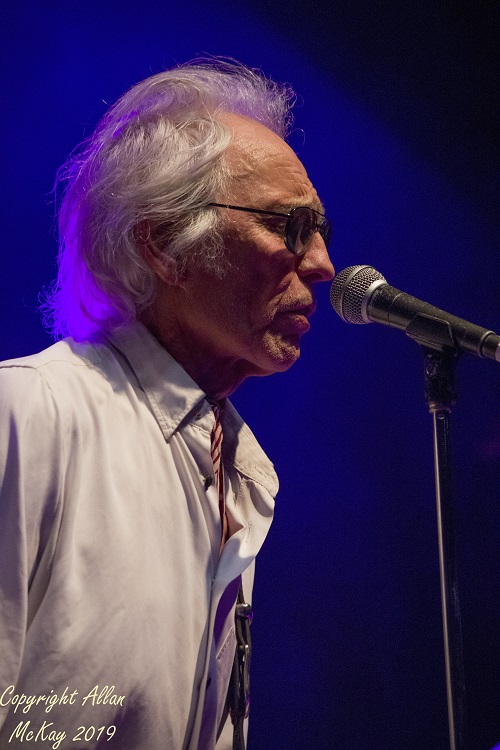
6th Commandment – Ignore the setlist. It’s a standing joke with band and fans. The only reason it’s there is to give the fans at the front a chance to gamble on how far the band get down the list before taking the scenic route (usually two or three songs, if you ever want to place that particular bet).
7th Commandment – Prepare to be entertained. This is a phenomenal bunch of musicians. They deserve to be namechecked individually. The Asbury Jukes are: Tom Seguso (drums), John Conte (bass), Jeff Kazee (keys), Glenn Alexander (guitar), Chris Anderson (trumpet), Neal Pawley (trombone), John Isley (sax) and Southside Johnny. And let’s not forget Joe Prinzo and Hood who hold it all together. I haven’t mentioned vocals because they all can, and do, sing. Check out the harmonies on “Walk Away Renee”.

8th Commandment – Show your appreciation. These guys are seriously good players. As an ensemble they build a solid platform for Southside to deliver his honey-over-gravel vocal, but everyone gets at least one solo during the set and Jukes fans show their appreciation of the solos in the same way the audience in a jazz club would. And it’s always well-deserved.
9th Commandment – Expect the unexpected (I know, but it’s worth repeating). The band doesn’t know what’s coming next, so why would the audience? There are some songs that you would expect to hear every time (“The Fever”, “I Don’t Want to Go Home” and probably “Walk Away Renee”) but the rest of the set’s up for grabs. Southside has a huge back catalogue to choose from and the band has a phenomenal repertoire of covers to call on, so the set includes seventies classics like “Love on the Wrong Side of Town”, “This Time Baby’s Gone for Good” and “Without Love”, “Cadillac Jack” and “Woke Up This Morning” from the blues album and “Spinning” from “Soultime”. Throw in the covers; “Ride the Night Away” (J Geils Band) and the Willy DeVille song “Mixed-Up, Shook-Up Girl” and you’ve got a great night.
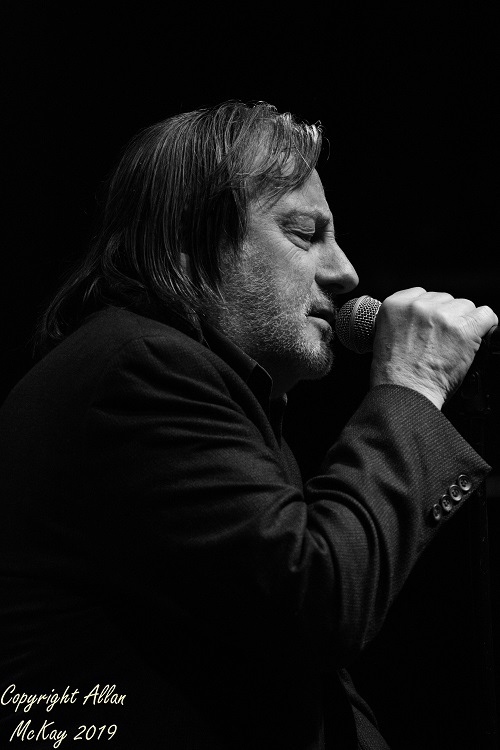
10th Commandment – It’s all about the band. In Johnny’s opinion, this is the best incarnation of The Jukes (watch out for the interview in a few days) and the partnership with Jeff Kazee is a huge part of that. Both have superb voices and the combination of Jeff’s high tenor and Johnny’s rich baritone is a thing of rare beauty. And that’s before we even get to the quality of the playing.
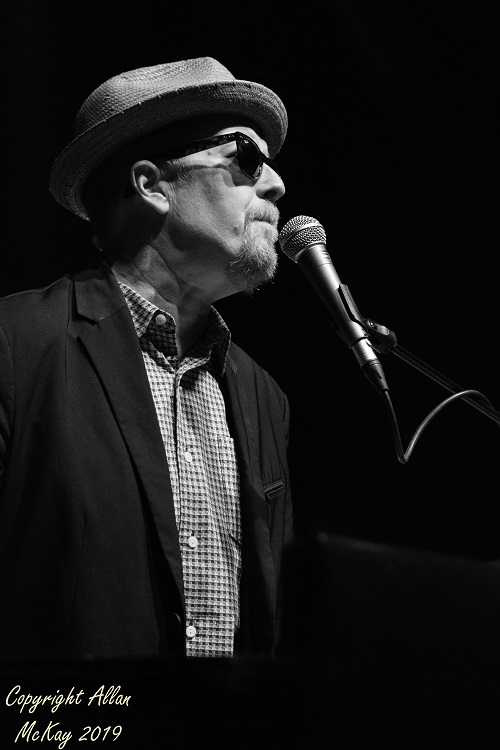
And that was Friday night at Shepherd’s Bush Empire; I can’t think of a better way to spend a Friday.
There was a fleeting reference in the interview I did before the soundcheck to retirement. You never know if any given Jukes gig is going to be the last you’ll see, so make the most of it. Next time they’re in the UK, I’ll see you down the front.
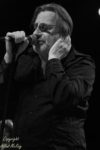 Ok, a couple of little stories for ya from Shepherd’s Bush Empire. First one’s from 2010.
Ok, a couple of little stories for ya from Shepherd’s Bush Empire. First one’s from 2010.
Backstage at a Jukes soundcheck, I was loitering waiting for Southside Johnny to arrive for an interview and trying pretty unsuccessfully to pretend I wasn’t nervous. I mean why would I be, this guy had only been a hero of mine for over thirty years and this was my first interview with him. Think about something else, listen to what’s happening down on the stage at the end of the soundcheck. So I did and it was unusual; it was Jeff Kazee singing something I had never heard at a Jukes show. Jeff had missed the European mainland leg of the tour because of a family bereavement and was doing his first gig in London. Fast forward about four hours and that little bit of distraction comes back to hit me like a sledgehammer as Jeff lets out his feelings in the most public way with a heart-rending, tear-jerking version of “Many Rivers to Cross”. If you wanted a definition of catharsis, this was it; it would have melted a heart of stone. Did I cry? And then some, and I wasn’t on my own. It was the most moving thing I’ve ever experienced at a gig, and that’s a lot of gigs.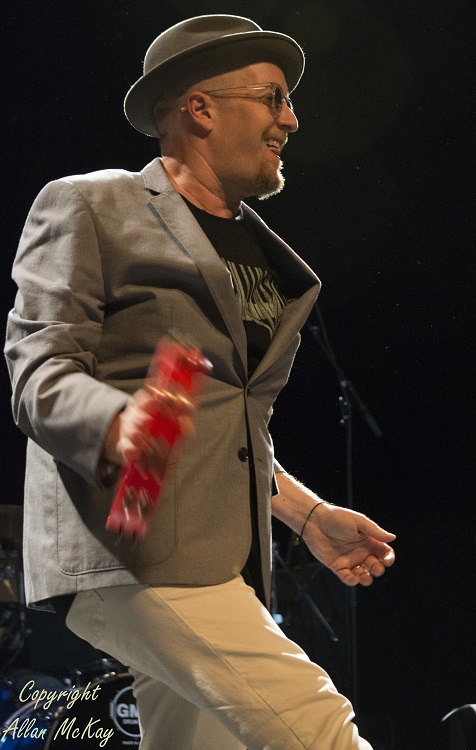
Skip forward just a year to October 21 2011. The Reverend Harold Camping had predicted (for the second time) that the world would end on that day. On stage at the Empire, it was beginning to look like he might be right. From the start of the set, there were complaints from the band about the monitor mix and just as the crew got that sorted out, another gremlin raised its head in the shape of Glenn Alexander’s guitar amp; it wasn’t amplifying. You’re on stage, the set’s just catching fire and suddenly your equipment blindsides you. Take losing your wi-fi for an hour and multiply it by a hundred; you’re getting close to the level of frustration on stage left that night. Long story short, it took three amps before the glitch was solved; the only problem now was to get the gig back on track, so what would the mainman do. The mainman called a Sonny Boy Williamson tune, “Help Me”, throwing the spotlight back at Glenn to harness his frustration and kickstart the show; which it did, with a vengeance. That’s a great band and bandleader in action right there.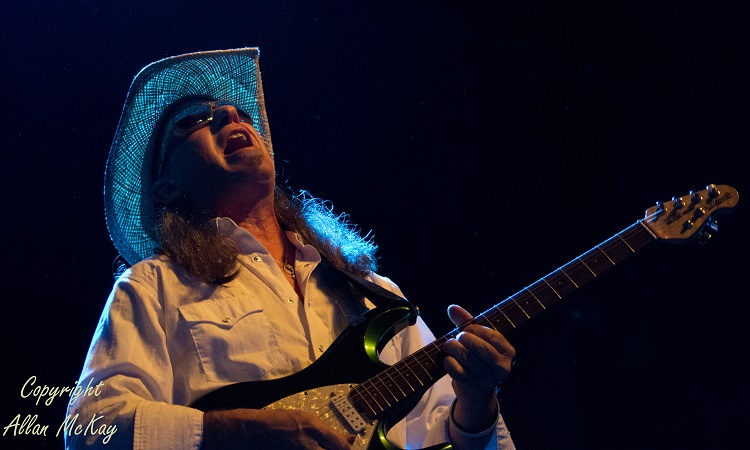
And, honestly, it’s not for everyone. If your thing is a setlist that’s been rehearsed to within an inch of its life, absolutely note-perfect and with a synched lighting plot (and I’m honestly not knocking that) this isn’t the gig for you. However, if you want a set that’s unpredictable, packed with powerful vocal and instrumental performances and great tunes, this definitely is for you. And I haven’t even mentioned my favourite combination yet. Cheese and onion, sweet and sour, trouble and strife don’t even come close – it’s horns and Hammond, Hammond and horns (see, it’s even alliterative). The recipe’s pretty simple; get seven of the best live musicians you can find, make sure they know all of (ok, most of) the songs and give them plenty of opportunities to express themselves. When those guys are Jeff Kazee (keys), Glenn Alexander (guitar), John Conte (bass), Tom Seguso (drums), John Isley (sax), Chris Anderson (trumpet) and Neal Pawley (trombone) each performance will be special and different. Now, that I will go see and hear any time.
So why am I telling you all of this now? Easy, there’s a couple of those increasingly rare opportunities to see Southside Johnny and the Asbury Jukes in the UK on a mini tour in March 2019. The band’s playing Glasgow (St Luke’s) on March 19th, London (Shepherd’s Bush Empire) on March 22nd and Holmfirth (Picturedrome) on March 23rd and 24th. Why two gigs at The Picturedrome? Because the first one sold out – obviously the North of England knows about good music. These UK gigs are precious because it ain’t cheap to bring an eight-piece across the Atlantic and you never know how long it is until the next tour.
So get yourself some tickets for one of the remaining shows and treat yourself to one of the best live bands in the business. What will they play? I don’t know and, most likely they don’t know, but it will be special and it won’t be anything like the set they played the previous night. See you at The Bush.
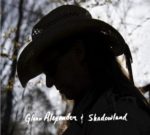 You never know where the next review’s coming from; could be the inbox, could be the letterbox, could be backstage at a gig. Yeah, it’s the last one. A couple of weeks ago, Glenn Alexander slipped this album into my greasy mitt backstage at The Forum in Kentish Town. Glenn’s the guitar player for Southside Johnny and the Asbury Jukes (amongst other things) and he released this solo album last year produced by the Jukes saxophonist, John Isley. If you’re a Jukes fan and you look at the credits for the album, you’ll recognise most of the names; when you work with world-class musicians in the day job, why not use those guys when you pursue your own vision?
You never know where the next review’s coming from; could be the inbox, could be the letterbox, could be backstage at a gig. Yeah, it’s the last one. A couple of weeks ago, Glenn Alexander slipped this album into my greasy mitt backstage at The Forum in Kentish Town. Glenn’s the guitar player for Southside Johnny and the Asbury Jukes (amongst other things) and he released this solo album last year produced by the Jukes saxophonist, John Isley. If you’re a Jukes fan and you look at the credits for the album, you’ll recognise most of the names; when you work with world-class musicians in the day job, why not use those guys when you pursue your own vision?
I’m not giving you a detailed biography of Glenn Alexander; you can find that anywhere. All I’m saying is that this album proves conclusively that Glenn is a lot more than just an incredibly good guitar player. The album opens with the fairly straightforward boogie of “If Your Phone Don’t Ring”; it’s great fun, the horns are every bit as good as you expect the New York Horns to be and it’s a joyous start to the show. Without reading the sleeve notes, it’s obvious that the second song “Earl Erastus” is deeply personal for Glenn. It hints at Jerry Reed’s “Amos Moses” and it’s a tribute to Glenn’s granddad, who raised six kids during the Depression; it has huge emotional power and a lovely New Orleans horn coda of his favourite hymn (I’m guessing) featuring a vocal from Oria Aspen.
From there on in, it’s a melting-pot of the influences flowing over a teenager growing up in the centre of the USA; there’s the funky soul and Elvis-referencing “Memphis Soul”, the country feel of “I Picked the Wrong Day (To Stop Drinkin’)”, the horn-fired shuffle of “Get A Life” (featuring Southside on harmonica) and the slow blues of “Blues For Me & You”, a duet with Oria Aspen contrasting Glenn’s rough-hewn blues vocal with Oria’s more pure jazz stylings.
You might think that was enough, but there are still surprises to come. The album’s penultimate song, “The Odds Are Good”, proves that Glenn Alexander’s not just about melody and guitar solos; the lyrics are clever, and in the style of Dylan or early Springsteen. This guy is much more than a great rock guitarist, he’s a very gifted songwriter and a pretty good singer in a Joe Walsh kinda style. There’s no real commercial imperative behind this album, it was created for the sheer joy of making music with stunningly good players. Great songs, Hammond and horns; this is the business, what more do you need?
“Glenn Alexander & Shadowland” is out now on Rainbow’s Revenge Records.
 Want to know why Southside Johnny still has a fanatical fanbase after over forty years? It’s really simple: he has a stellar group of musicians working with him, they have a lot of fun, and the audience never knows what’s coming next. There are a few songs that are non-negotiable, but for the remainder of the set it’s like “Thunderbirds”; anything can happen. Where else would you hear someone drop a verse of the Ramones classic “I Wanna be Sedated” in the middle of an instrumental break. And, talking of surprises, who expected Gilson Lavis (Squeeze and the Jools Holland Rhythm and Blues Orchestra) to make a guest appearance for the blues classic “Key to the Highway”? And did you know that Johnny and Jeff Kazee are huge fans of Squeeze?
Want to know why Southside Johnny still has a fanatical fanbase after over forty years? It’s really simple: he has a stellar group of musicians working with him, they have a lot of fun, and the audience never knows what’s coming next. There are a few songs that are non-negotiable, but for the remainder of the set it’s like “Thunderbirds”; anything can happen. Where else would you hear someone drop a verse of the Ramones classic “I Wanna be Sedated” in the middle of an instrumental break. And, talking of surprises, who expected Gilson Lavis (Squeeze and the Jools Holland Rhythm and Blues Orchestra) to make a guest appearance for the blues classic “Key to the Highway”? And did you know that Johnny and Jeff Kazee are huge fans of Squeeze?
It isn’t just about Southside Johnny; it’s about a group of eight people who are very good at what they do – take a bow Jeff Kazee (keys), John Conte (bass), Tom Seguso (drums), Glenn Alexander (guitar), John Isley (tenor sax), Chris Anderson (trumpet) and Neal Pawley (trombone) – and to enjoy every minute of it. They can all sing, so the harmonies are spectacular, and they’re a band, not eight individuals (don’t take my word for it, read Jay Lustig’s just-published interview with the man himself).
Now if you come to a Jukes show expecting a carefully-choreographed run-through of the same songs they played last night, and the night before and so on, you came to the wrong show. The audience at a Jukes show expects to be surprised, they expect randoms (though I bet not too many expected “I Wanna be Sedated”) and they want the thrill of not knowing what’s going to happen next. Hell, most of the band don’t even know that. And what they got, from the piano intro and horn riff of “Love on the Wrong Side of Town” was about 135 minutes of old songs, new songs, Lyon/Kazee songs, Little Steven songs, covers, blistering solos from the horns, guitar and keys and just enough quiet moments to offer a contrast to the power of the rest of the set.
And standouts for the night? Well, they hit the ground running with punchy versions of two early classics, “Love on the Wrong Side of Town” and “This Time It’s for Real” and then time-warped forward forty years to “Spinning” from “Soultime” and for over two hours it was a roller-coaster; all killer, no vanilla. You wanted blues; you got it. You wanted soul; you got it. You wanted rock; you got it. You got a singer who’s been in the business over forty years and still wants to go out every night and give every audience a unique experience aided and abetted by the best band in the business. It really doesn’t get any better than that, and every UK gig now is a bonus; make the most of it. Ladies and gentlemen, I give you Southside Johnny and the Asbury Jukes – living legends.
You can see the photos from the gig here.
 So why would anyone in their right mind want to take a four hundred mile round trip in foul weather while jet-lagged to go to a gig? Well, if it was the only opportunity in two years to see Southside Johnny and the Asbury Jukes in the UK, then it’s a small price to pay. And, let’s be completely upfront about this, I’m a fan and I have been for, well, let’s say a long time. I’ll give you a clue how long, I bought their first album, “I Don’t Want to Go Home”, in 1976. As you might expect with an eight/nine/ten piece band that’s been around for forty years, they’ve been through a few line-up changes; well, ok, Southside Johnny is the only member left from the original line-up, but you can call that evolution if you like. Following the release of the latest Jukes album, the superb “Soultime!”, the band has been on the road in the US, the UK and Europe promoting the album.
So why would anyone in their right mind want to take a four hundred mile round trip in foul weather while jet-lagged to go to a gig? Well, if it was the only opportunity in two years to see Southside Johnny and the Asbury Jukes in the UK, then it’s a small price to pay. And, let’s be completely upfront about this, I’m a fan and I have been for, well, let’s say a long time. I’ll give you a clue how long, I bought their first album, “I Don’t Want to Go Home”, in 1976. As you might expect with an eight/nine/ten piece band that’s been around for forty years, they’ve been through a few line-up changes; well, ok, Southside Johnny is the only member left from the original line-up, but you can call that evolution if you like. Following the release of the latest Jukes album, the superb “Soultime!”, the band has been on the road in the US, the UK and Europe promoting the album.
And that’s why I was at Holmfirth Picturedrome staring at least four very watery seasons in the face in one day; I wouldn’t make this much of an effort for just any old band. Let me tell you what you won’t get at a Southside Johnny gig; you won’t get a performance that’s timed and sequenced to the millisecond to tie in lighting plots, dancers, additional backing tracks and live autotune. What you will get is eight stunningly good individual musicians pulling together to give a hugely devoted audience a great show. The tour is in support of “Soultime!”, so when the set opened with a storming version of “I’m Not That Lonely”, it was no surprise. “All I Can Do” and the lead track “Spinning” also appeared early in the set, while the ballad “Words Fail Me” featured in the encore.
With a fanatical audience, each demanding to hear their personal favourite Southside song, and with forty years’ worth of Jukes albums to choose from (not to mention the odd cover), it’s always a bit of a high-wire act; and that’s why people go to see this band again and again, because they know that every show’s unique. It may not always be perfect, but it’s always different. On this night it took a couple of attempts to nail the intro to “It Ain’t the Meat (It’s the Motion)”; you have to expect a few heart-stopping moments when the acrobats are freestyling.
While the band plays that familiar blend of rock and soul, the show has an unmistakable jazz feel. The horns (John Isley, Chris Anderson and Neal Pawley, playing saxes, trumpet and trombone respectively) have serious jazz credentials (as The New York Horns) as does guitarist Glenn Alexander. When the solos came along (and there were plenty of them), the audience applauded the soloists enthusiastically, in true jazz club style. The horn solos were astonishingly good (particularly John Isley’s solo in “Passion Street” which moved away from the smooth melodic feel of Joey Stann’s recorded version to an impassioned stuttering, staccato version) but occasionally the horns took stage centre, ramping up the excitement with New Orleans style counterpoint ensemble playing.
The rhythm section of Tom Seguso (drums) and John Conte (bass) rarely catches the spotlight, but the band only works if they’re on the money, and they always are. Jeff Kazee, now Johnny’s main songwriting partner is also the perfect onstage partner, his high, soulful tenor voice blending perfectly with Johnny’s rich baritone as a duettist and harmoniser. As for Southside, he still takes responsibility for pulling all the strings, but now he can rely on all of The Jukes to take the pressure off at any time.
The only way you can pull off a gig like this is to have great musicians working with you; the downside of having great musicians in the band is that they get bored really easily. The challenge for Southside Johnny, through every single gig, is to balance those priorities and get the best out of the entire band. At The Picturedrome, the audience had a great time and the band looked they were having a ball as well. Job done.
Now if only we could do something about that group we see at every gig, ‘the men who can’t clap on two and four’ (or any beat at all to be honest) and ‘the men who can’t carry a tune in a JCB scoop’, we’d all be much happier.
You can find the setlist for the gig, courtesy of Miss October, here and photos from the gig here, courtesy of, well, me actually.
And just a quick word about Broken Witt Rebels from Birmingham whose muscular riffs, powerful vocals and stage presence warmed the audience up nicely for the headliners.
There was a time earlier this year, when I was hobbling around with the help of a crutch, when I thought that I would have difficulty scraping together five gigs that I’d actually seen; how wrong was that? It’s been difficult to narrow this list down to five, so I think there might be a few honourable mentions as well. So, in absolutely no order at all are my favourite live shows of 2014.
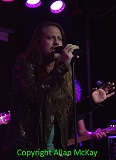 Jim Stapley Band at 93 Feet East
Jim Stapley Band at 93 Feet East
Jim Stapley’s debut album almost made my top five albums, but there was absolutely no doubt about this live performance. Jim has a phenomenal soulful rock voice and he has pulled together a superb band to deliver the songs live. This was an album launch gig featuring virtually all of the album “Long Time Coming” (plus a cheeky cover of Rihanna’s “We Found Love”) and, despite atrocious weather and a half-full venue, Jim and the band gave it everything. The songs were strong, the band were cooking on gas, but what a voice.
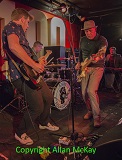 Stone Foundation at The 100 Club
Stone Foundation at The 100 Club
Towards the end of a very busy year for the band, this was an appearance at the annual Delicious Junction bash and another headline slot at The 100 Club with a set based solidly on the “To Find the Spirit”. All of the band members are great players but, despite the solos, this isn’t about individuals, it’s about the group; it’s the perfect combination of a locked-in rhythm section, keyboards and horns. It was also a chance to see how the new members Gareth John (trumpet and flugelhorn) and Rob Newton (congas) had bedded in. It’s fair to say that the horns sounded better than ever and the congas added a little bit of icing on the cake. It was a great set from the band and a stomping encore of “Jumping Jack Flash”. Enough said.
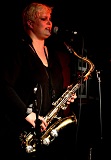 Little Devils at The 100 Club
Little Devils at The 100 Club
Yeah, The 100 Club again and it’s blues Jim, but not as we know it; Little Devils are fronted by singer and multi-instrumentalist (sax and flute), Yoka. The rhythm section of Graeme Wheatley and Sara-Leigh Shaw (aka the Pintsized Powerhouse) built a solid base for Big Ray’s guitar and Yoka’s vocals and instrumental solos. The quality of the playing alone would put this gig up there with the best this year but this is also great fun; the band obviously enjoy themselves and the audience will always pick up on that. Great performances and big smiles all around the room; that’s a pretty good combination for a great night.
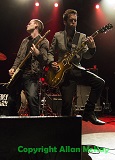 Federal Charm and Ian Hunter’s Rant Band
Federal Charm and Ian Hunter’s Rant Band
This was the final night of the Ian Hunter tour and the audience was in a party mood. It’s not the first time I’ve seen Federal Charm but they seem to get better every time. They got a huge cheer when they strolled on to the Shepherds Bush Empire stage and powered their way through thirty minutes of melodic blues rock featuring their powerful cover of “Reconsider” before making way for Ian Hunter. What a legend; played for two hours and kept the audience spellbound throughout, and the voice still sounds great. We even got an appearance from Mick Ralphs for the encore. Top night.
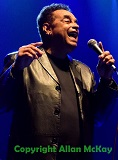 Gary Bonds, Southside Johnny and The Asbury Jukes
Gary Bonds, Southside Johnny and The Asbury Jukes
Now this sounded like a great idea. 60s legend, and big influence on the Asbury Park scene teams up with Southside Johnny for a UK tour; I’ll even pay for tickets for that. Albany Down, despite a ten-second soundcheck, got the audience nicely warmed up for the main event which was a set from Gary Bonds (with some help from Southside) and a set from Southside (with a little help from Gary Bonds), both backed The Asbury Jukes. As ever, the superb musicians (Jeff Kazee, Tom Seguso, John Conte, Glenn Alexander, John Isley, Chris Anderson and Neal Pawley) fitted together perfectly and reacted instantly to any curveballs thrown by Southside. Seriously great players but they know how to have a bit of fun as well. They’re a great attraction as The Jukes, but Gary Bonds just tipped it over the edge.
It was incredibly difficult to narrow this down to only five gigs and there are a few more which deserve honourable mentions. I saw Vera Lynch three times (including their final gig at The Barfly in Camden and a gig in a Shoreditch shop window), The Kennedys and Edwina Hayes at Green Note and Dean Owens and Black Scarr on Eel Pie Island and all of those were great nights. Here’s to many more in 2015.
So, purely in alphabetical order (by album title) because there’s no way I’m trying to rank these in order of preference. They’re all very different and I can recommend any one of them to any real music fan; these are my five favourite albums of 2014.
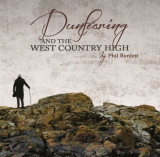 “Dunfearing and the West Country High” – Phil Burdett
“Dunfearing and the West Country High” – Phil Burdett
Phil Burdett’s latest album (on Drumfire Records) was a complete surprise for me. I’d heard Phil play a solo acoustic set a couple of years ago on a night out with the Riot Squad, but this was a completely different beast. “Dunfearing…” is the first part of the “Secular Mystic” trilogy, which should be completed with the release of parts two and three in 2015. It’s an album that sounds gorgeous; you could just sit and let its mix of folk, rock, country and a bit of jazz wash over you, but a little bit of extra effort and careful listening brings out all of the detail that Phil and the musicians have packed in to it; and there’s a lovely tribute to the late Jackie Leven. After reviewing the album, we also managed to grab an interview with Phil during the summer, which is a fascinating insight into a great songwriter.
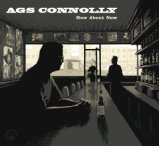 “How About Now” – Ags Connolly
“How About Now” – Ags Connolly
By sheer coincidence, also on Drumfire records, was the debut album from Ags Connolly, “How About Now”, which is now also available in a lovely limited edition vinyl pressing. Ags is based in Oxford but his roots are deep in the American South and his genre is a country offshoot known as Ameripolitan. He takes the outlaw attitude of artists like James Hand, Willie Nelson, Johnny Paycheck et al and gives it a personal twist with some very poignant songs. The album was produced in Edinburgh by his Drumfire labelmate, Dean Owens, and works well with full country band arrangements as well as the powerful solo acoustic guitar backing of the closing song “How About Now” (which was a genuine one-take recording).
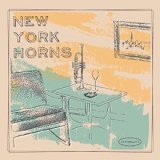 “New York Horns” – New York Horns
“New York Horns” – New York Horns
I know; you’re surprised that I’ve picked a jazz album. Truth is that I love to hear a good horn section, and most horn players away from the day job like to stretch themselves with a bit of jazz. The horns in question are John Isley (saxophone), Chris Anderson (trumpet) and Neal Pawley (trombone), better known as the horn section of The Asbury Jukes, aided and abetted by Jeff Kazee (keys) and Glenn Alexander (guitar). There isn’t a bad, or even a mediocre track on the album and with moods ranging from the blues of “Strollin’ with Sean” through the evocative, mellow “Morningside at Midnight” to the 24-carat soul of “Can’t Stand to See You Cry”, there’s something for everyone.
 “To Find the Spirit” – Stone Foundation
“To Find the Spirit” – Stone Foundation
And continuing on the soul theme, how about some genuine home-grown English West Midlands soul? Stone Foundation has been steadily building up a devoted following for about ten years now, but “To Find the Spirit” may turn out to be the game-changer for them. The band takes influences from all over the soul spectrum to create a sound very much of this century but which appeals to very disparate groups of fans. The album grabbed me from the first few bars with the Hammond and horns intro of “To Find the Spirit” and impressed from start to finish. After 10 months (and seeing the band live three times), the standout song is definitely “Don’t Let the Rain”, driven along by Neil Sheasby’s slinky bass groove but, again, there’s no filler here.
 “Tone, Twang and Taste” – Pete Kennedy
“Tone, Twang and Taste” – Pete Kennedy
Now the reason this one’s here is that Pete Kennedy (one half of one of my favourite groups, The Kennedys) decided to pay tribute to the pioneers of the electric guitar prior to the rock ‘n’ roll era; the guys who had grab the interest by using technique and melodic invention rather than volume and a thudding 4/4 beat. Pete is a superb technical musician and “Tone, Twang and Taste” is so obviously a labour of love; every song is played with immaculate attention to detail and they all sound like they were great fun to do, particularly Pete’s ukulele version of “Rhapsody in Blue”. The commercial possibilities for this album were always very limited, and that’s one of the reasons I admire Pete so much for producing something that made me smile from start to finish.
You can read the original reviews of these albums on the site complete with all of the links to the songs on Spotify or Youtube; just type the title into the search box and you’re away. Go on, have a listen; they’re all great albums.
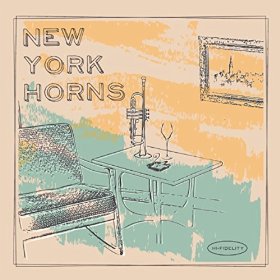 It’s relatively easy to record an album these days; you can do it at home or maybe in a studio and it won’t cost you the earth. You can organise your own distribution online or at live shows; you won’t get rich but you will get some return for your creativity. Not everything released by this route is good; there are way too many vanity projects, but occasionally something really worthwhile emerges. Sometimes a group of talented and like-minded musicians get together and just play the tunes they really want to play. If it makes a few dollars, that’s fine, but that’s not really the point because the musicians are playing the music they want to play and having a bit of fun with their own original material and a few covers. Very, very occasionally the result is an album packed with, superb performances and arrangements that you want to listen to again and again. “New York Horns” is one of those.
It’s relatively easy to record an album these days; you can do it at home or maybe in a studio and it won’t cost you the earth. You can organise your own distribution online or at live shows; you won’t get rich but you will get some return for your creativity. Not everything released by this route is good; there are way too many vanity projects, but occasionally something really worthwhile emerges. Sometimes a group of talented and like-minded musicians get together and just play the tunes they really want to play. If it makes a few dollars, that’s fine, but that’s not really the point because the musicians are playing the music they want to play and having a bit of fun with their own original material and a few covers. Very, very occasionally the result is an album packed with, superb performances and arrangements that you want to listen to again and again. “New York Horns” is one of those.
So, who are the New York Horns? Well the horn players are Chris Anderson (trumpet and flugelhorn), John Isley (tenor and baritone sax and bass clarinet) and Neal Pawley (trombone and vocals) and they’re better known as the horn section of Southside Johnny the Asbury Jukes. Here they’re aided and abetted by fellow-Jukes Jeff Kazee (piano, Hammond B3, keys and vocals) and Glenn Alexander(guitars, dobro, mandolin and vocals) and a rhythm section of Shawn Pelton (drums and percussion) and Tony Tino (electric bass).
The album opens with a very different instrumental take on KT Tunstall’s breakthrough song “Black Horse & the Cherry Tree”. Where the original builds gradually by using a loop pedal for instrumental and vocal parts, the NYH version comes in, after a quick guitar intro, at full strength with Latin American percussion (courtesy of Marc Quinones) and perhaps a hint of early Santana. Chris Anderson’s tone poem “Morningside at Midnight” is next, taken at a walking tempo, and evoking the spirit of Morningside Heights with electric piano, wah-wah guitar and unison sax and trumpet. The Hank Williams classic “Hey Good Lookin’” is the first vocal piece, driven along by a guitar riff and horn fills before the sax, guitar and Hammond solos kick in. “Song for Levon”, a Chris Anderson and John isley co-write is a tribute to Levon Helm. It’s stately and mournful in classic New Orleans tradition and features Southside Johnny as guest harmonica player.
The uptempo jazz-funk of John Isley’s “Little Miss Thing” wouldn’t sound out of place on either of Donald Fagen’s first two solo albums and features the first trombone solo on the album from Neal Pawley; it’s great fun. “Can’t Stand to See You Cry”, written and sung by Jeff Kazee, is a powerful soul song with a superb plaintive vocal and an arrangement that Allen Toussaint would be proud of while “Strollin’ With Sean” is a fairly straightforward blues driven along by a horn riff and it’s another chance for the guys to solo for all they’re worth and have a great time. The final cover on the album is John Hiatt’s “Little Head” which retains the feel of the original while adding punch with horn fills.
John Isley’s “78 Below” opens with an uptempo Nile Rodgers –style lead/rhythm riff which, with the punchy bass, drives the piece along underneath a staccato muted trumpet melody before the mood mellows again with Chris Anderson’s “More Than Tears”. Opening with a restrained combination of piano, acoustic guitar and mandolin, this moody and melancholic piece is perfect for the flugelhorn which Chris uses to carry the main melody. John Isley’s “Under the Hood” is an atmospheric piece using Hammond and the horn ensemble to create the mood and features a muted trumpet solo from Chris Anderson. The album’s closing song, “Nothing Left to Say”, opens slowly in New Orleans jazz funeral style, with a guest vocal by Christine Ohlman before erupting just before the halfway mark into uptempo New Orleans jazz with trumpet and sax counterpoint. There’s also a lyrical message here which underpins the whole album; however bad things get, there’s always music to pull you back, whether you play it or listen to it. It’s a perfect way to close the album.
The beauty of this album is that it was made because the musicians involved really wanted to make it. They had a lot of ideas and they wanted to get those ideas out there to people who might want to hear them. It’s not about focus groups or marketing teams; it’s about strong, sometimes very personal, material arranged well and played superbly. If you need to label it, I suppose it’s jazz, but it also pushes out in other directions as well, towards funk and old school soul; there’s certainly plenty of variety on display. Check out some of the song links here and think seriously about buying yourself a copy, if only to let a bunch of great musicians know that some people out there are actually getting the message.
Available now from Amazon and iTunes.
Last Friday I had the opportunity to spend some time with the legendary Southside Johnny before the final show of his UK tour, featuring Gary “US” Bonds, at Shepherds Bush Empire. He was entertaining and engaging (as always):
AM – We did an interview here three and a half years ago and at that time you spoke to me about this acoustic thing that you might or might not be doing, which was really big news at the time and that’s happened now, so how’s that going?
SJ – It’s really good, it’s a fun thing. It’s really stripped down; we travel in a van together, we have breakfast in the morning as a band (there’s only six of us, with the road manager) and we set up our own equipment and tear it down and it really feels like the old days when you used to have to do that. It was a complete commitment to the whole day of travel, set up, play, tear down and travel again and even though I’m kinda long in the tooth I really enjoy it because it seems so organic and basic; there’s no star turns at all. I love playing acoustic music and it gives us a chance to play George Jones and Emmylou Harris and Bob Dylan and Tom Waits and some Bruce in a different format.
AM – You mentioned a few country artists there; you’ve always been a country fan haven’t you?
SJ – Yes I liked country when I was very young. What I didn’t know is that my mother, way back in the thirties when the ukulele was the big thing, she bought a ukulele from Sears Roebuck and she would sit on the porch with her father (her mother had died young) and some neighbours, and they would sing country songs, so I guess it’s in my blood, it’s the Irish part of me.
AM – I’ve heard you play “He’ll Have to Go” (country classic made popular by Jim Reeves) at The Astoria, I think.
SJ – Well, Soozie Tyrell, who plays violin with Bruce, she has a country band in New York City, and I would go up and do lots of songs with her because they’re real singer’s songs, they’re story songs with great melodies so it’s fun to make that kind of music.
AM – The old Jukes revolving door seems to have slowed down a little…
SJ – Not too much. We’ve got a new saxophone player, John Isley; I think (drummer)Tom Seguso’s been over here.
AM – At the time of the last interview, Joey (Stann, tenor sax) and Ed (Manion, baritone sax) were still with you but they’re obviously off doing other things now. There seems to be lots of side projects going on as well now that the New York Horns have made a record.
SJ – These days it’s a lot easier to make a record for a little money and it’s also easier to manufacture; for a buck apiece you can make as many CDs as you want and there’s a profit margin once you’ve paid for the studio time and the musicians and all the rest of it. I’m lucky that Jon Bon Jovi lets me use his studio but, even if he didn’t, studio time’s not as expensive as it used to be, home recording’s easier and the internet makes it easy to get distribution to all your fans round the world. It’s a good time to be a musician because you can do all the little things you want to do without incurring great expense.
AM – Did the side projects always happen to a certain extent; do we just hear about them more because of social media?
SJ – We’ve always done those things; Bobby (Bandiera, guitar, now playing with Bon Jovi) and I went out for months, here and there, doing a lot of charity gigs and they put us on a plane, in business class, just him and me and a guitar and harmonicas. We went all over and played charity things and it was just a chance to play in hotels and every little place you could find and it was a lot of fun because it was no stress.
AM – I saw you at Sheffield City Hall in 1995, I think, just the two of you doing the stripped back thing and it was a great night.
SJ – Well, if you have confidence in what you’re doing and you have material you think you can accomplish with just a guitar and a harmonica it’s a chance to explore all that too. Years ago Bobby, Rusty Cloud, David Hayes and I played in Paris at the Chesterfield Club. We did a two-week stint there with very little publicity and we rode the Métro and that was a lot of fun too. We all stayed in the same hotel, this funky little place and it was two weeks in Paris. I’m lucky I’ve had the chance to do those things and just explore what making music means other than pedal-to-the-metal trying to earn a living. I can do just about anything I want now. I’m never going to be rich, I’ve known that from the very beginning so there’s not a great stress to be a big star and make a lot of money; I make a living and that’s all I want. I just want to be allowed to do whatever kind of music I want to make.
AM – I was going through some of my very old Jukes records today and it struck me that after Billy Rush left, you got much more involved in the songwriting process; there’s not a lot of your songs on the early albums.
SJ – I was a writer back then but I would write certain things with certain people but the bulk of the song would be theirs and I’d say “forget it, I don’t want to have anything to do with it”. I wrote with Billy but I don’t have the kind of ego that I need to see my name on the album, but now with Jeff and Bobby the songwriting is really a collaboration so I get to write a lot of lyrics that I find interesting like “Into the Harbour” and “Winter in Yellowknife” and stuff like that which is not the norm for romantic love songs.
AM – On “Pills and Ammo”, it struck me that your name’s on every track as a writer. Do you have a certain way of working; do you do the lyrics and Jeff does the music?
SJ – It’s pretty much that way except that if I come up with a musical idea we’ll explore it and he helps me with lyrics; it’s a real collaboration in other words. I’ll come with an idea, a whole lyric and I’ll say “I think it sounds like this” and he’ll find a way to make it sound like what I want, but then he’ll say “what about this…” and we really try to bounce ideas off each other.
AM – I know Jeff’s a big fan of Squeeze and Difford and Tilbrook wrote in that way as well.
SJ – I’m a big Squeeze fan too.
AM – About your audiences; you’ve retained a very loyal audience in the UK. In the US, are the audiences different?
SJ – Well, they speak English. There’s people who come and see us a million times and there’s people who come and see us for the first time and usually we can win people over. It’s the energy and a lot of the music is made to lift you up so it’s not some shoegazer and it’s not some egomaniac, it’s really just music. I think one of the things that keeps people coming back is that it’s never the same night after night and I don’t know where it’s going to go and tonight’s going to be like that too because we’ve got Gary Bonds and we know what we’re going to do but when we get on stage, that may change.
AM – I’ve been watching Billy Walton live for a while and I’ve noticed that his crowd seems to be getting younger. I’ve seen teenagers at his shows but I’ve also seen people in their twenties who know all of the songs. I just wondered if that was happening with The Jukes.
SJ – We do get a lot of younger people; we had a bunch last night in Holmfirth, but we have our loyal fans and they’re the ones that usually get the first tickets and they’re older, but they bring their kids and some of them bring their grand-kids but anybody who’s willing to give us a shot we’re willing to play for as long as they come and have a good time and just enjoy themselves.
AM – November used to be the traditional time for a Jukes tour but the last couple of years you’ve been over during the summer. I’m guessing that’s because of festivals.
SJ – Yes. This year especially, because we had the Cornbury Festival to start it and we’re ending with Bospop in Holland so we had two festivals and we put a bunch of gigs in between and those get to be the anchor gigs. Unfortunately there’s new taxes in England, Foreigner Entertainer Tax (FET) and Hood, who settles everything got hit with it the other night and they wanted £1,400 for FET. Nobody knew exactly what it was but it’s legitimate and all that does is it makes it harder for bands like me to come over here; you can only lose so much money. On the one hand I guess they need the tax money but if they really need that, they should get all those people who hide their money offshore and let us poor bands try to play a little music.
AM – And a lot of musicians are hiding money offshore.
SJ – Well I’m not hiding any money; my money comes and goes and I get to see it as it goes past and that’s about it.
AM – Going back to the festivals, what’s the biggest gig you’ve ever played?
SJ – Probably Knebworth with Led Zeppelin. We did two shows; we did the first one, flew home and did a show in Washington DC, flew back and did the second show at Knebworth and flew home again, if I remember rightly, so it was a lot of flights. And we played about forty minutes but it was fun, it was a unique experience and we met some good people over here.
AM – As far as I can remember, and I was a long way away from the stage, it seemed like you got a pretty good response that day.
SJ – It seemed like that; of course we didn’t the full power that the headline act got (we don’t do that, if somebody opens up for us they get full power, but I’m not ever worried about a band opening up for us, I hope they do well). But I thought Led Zeppelin was terrible; there was no bass in the mix in the audience.
AM – That’s all the serious stuff but I’ve got couple of other questions for you. You’ve now got a huge body of work to choose from when you play; is there anything you feel can’t be left out?
SJ – Well, there’s nothing that can’t be left out, but I’m not there to just indulge myself, I’m there to give people what they want too and you split the difference. I know they want to hear “I Don’t Want to Go Home” and “The Fever” and “Trapped Again” or “Talk to Me” or “This Time It’s for Real” or “Love on the Wrong Side of Town” or whatever and you try to include those but when you twenty-two, twenty-three songs, there’s plenty of room for you to do what you want too. There are times when I say “I’m sick of this song, I’m not doing it” and it lasts for few months then it’s back in.
AM – Here’s one from my sister, who’s a big fan. Is there a song that makes you cry?
SJ – There’s a lot I guess. I’ve got some that I’ve written but Alison Krauss does a song called “I Can Let Go Now” which I think was written by Michael McDonald and it just kills me because I relate it to my mother. I don’t think that’s what it’s really about but for me it is and I just can’t listen to that song. There’s a lot; there are things that really touch me. I wouldn’t be doing if I didn’t get emotionally involved. When I was young and heard certain songs, I either got happy or excited or even felt sexy or touched, and to be part of that tradition is an amazing thing, but I’ve never really lost the idea that if someone sings a great song and really means it then I can get lost in the emotion.
AM – I find it really difficult to listen to “Many Rivers to Cross” after the version Jeff did here in 2010.
SJ – He really puts his heart and soul into it.
AM – Finally, hoping for another scoop, have you get anything in the pipeline?
SJ – Well, Jeff and I have written most of the songs for the next Jukes album; when we get it finished, I don’t know. We’re hoping to get in the studio, perhaps this winter and get it out some time next year. I’d love to get it out by Christmas but that’s just not gonna happen, and I’ve written some songs for a new Poor Fools acoustic thing and I’ve got a couple of other projects in mind too. I could retire if I wanted to, but then what would I do? I’d sit around the house, get fat and drink myself to death, and I can do that on the road.
AM – Johnny, many thanks for making the time for the interview.
SJ – My pleasure, any time.


